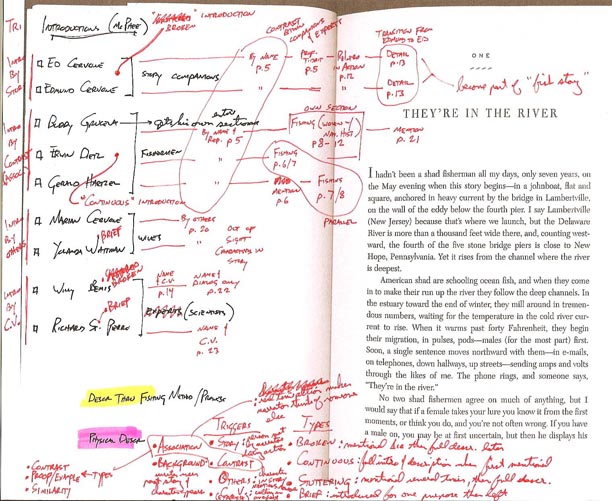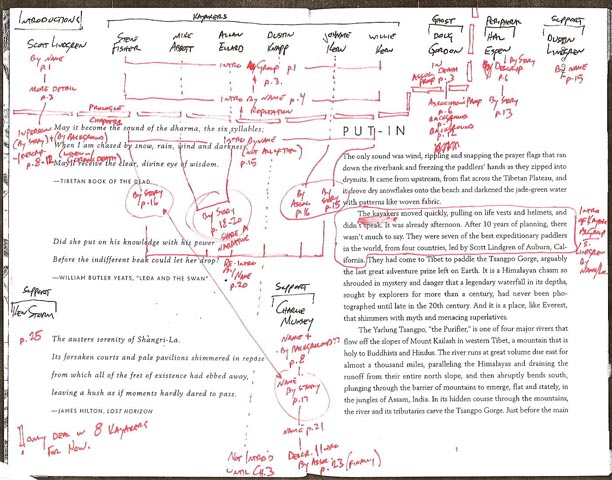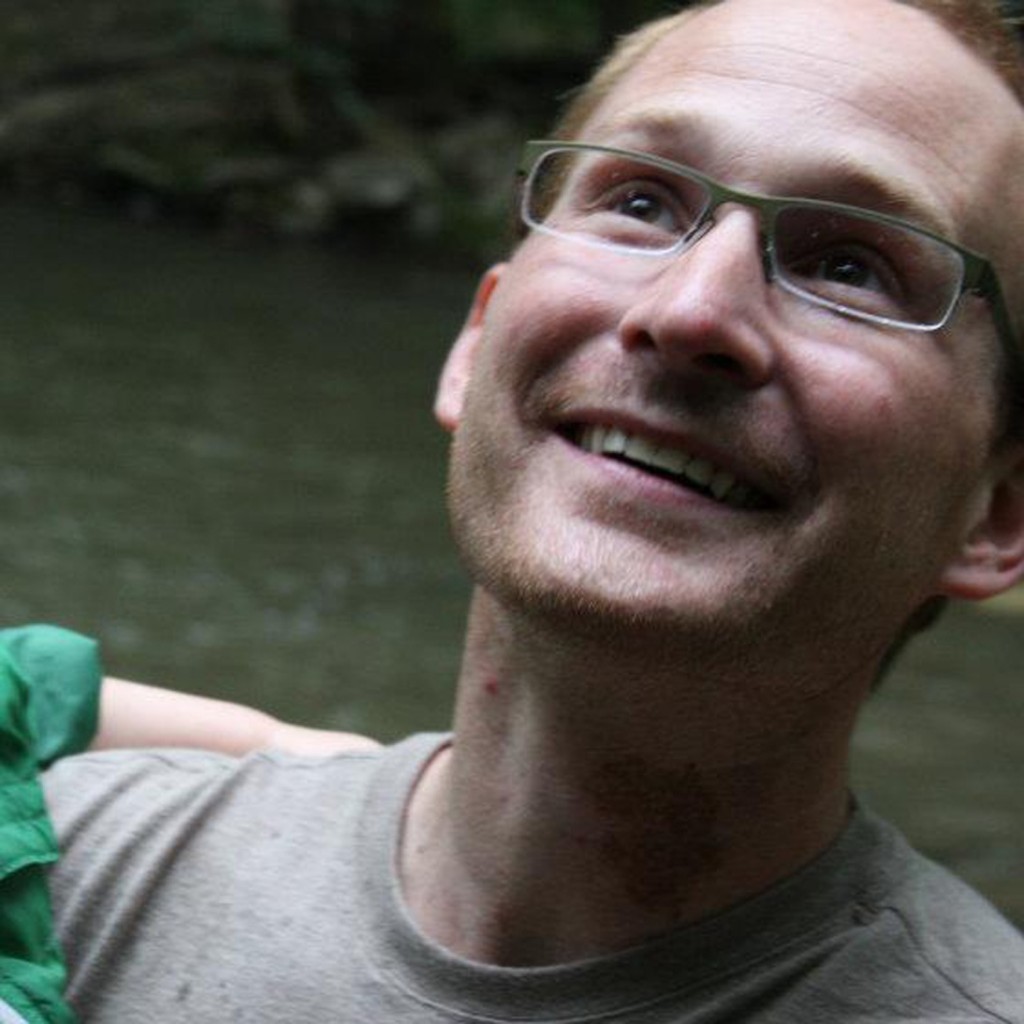It has been said that creative nonfiction authors like to write about themselves: I had a tumultuous childhood, I went a year without eating anything brown, I find gems of wisdom in the ingredient lists of common foodstuffs. That’s nice, but the real world isn’t populated solely with various iterations of the first person. Though all the “others” out there might interrupt our self-indulgent reveries, they often have something very important to say. So how can we carefully and strategically let them into our personal essays and our memoirs.
 McPhee’s “Founding Fish,” page one.
McPhee’s “Founding Fish,” page one.
I am, generally speaking, a science and nature writer. Therefore, so-called “experts” (actual scientists and naturalists) always poke their heads into my essays. In an effort to learn how to organize and orchestrate their entrances, I decided to look at the opening chapters of two books that are rich with interlopers: Founding Fish, by John McPhee, and Hell or High Water, by Peter Heller. (You’re gathering by now this is a critical essay DG asked me to tweak and post here. I, sadly, do not have the lucrative publication deal Mr. Farrell enjoys.)
McPhee’s book is an all-angles examination of one species of fish: the American shad. In the opening chapter, McPhee spends more than two hours reeling in one of these anadromites from the Delaware River. Woven into this primary narrative are segments about the landscape, the life history of the fish, and the key characters that will figure prominently in the remainder of the book. Heller follows a kayak expedition down Tibet’s Tsangpo River, which has never been successfully run. The author, a kayaker himself commissioned by Outside Magazine to follow the trek, doesn’t ever get into the river, but instead walks the shore with the “ground team” supporting the seven boaters. In the prologue and first chapter, Heller juggles the entrances of all seven kayakers and nearly a dozen other major and minor characters.
 Heller’s “Hell or High Water,” page one.
Heller’s “Hell or High Water,” page one.
In these two books, the authors use a variety of methods to introduce the large number of characters. This essay will examine the structures and triggers employed in introducing these characters. An introduction structure refers to how a character is brought into the story over time, and appears in these books in four types: continuous, suspended, stuttering, and brief. An introduction trigger refers to the immediate reason the character is introduced, and appears here in five types: by the story, by association, by background, by others, and by needed expertise.
Types of Character Introduction Structures:
Continuous: A continuous introduction includes a lengthy introduction and description of a character the very first time the character is encountered. McPhee uses this structure to introduce the three expert fishermen, Buddy Grucela, Erwin Dietz, and Gerald Hartzel. On page 5, these three men are mentioned for the first time: “[Cervone] knew he wasn’t fishing with Buddy Grucela. He knew he wasn’t fishing with Erwin Dietz or Gerald Hartzel – living figures in the Cooperstown of shad.” There is a short paragraph, and then McPhee begins a more than two-page description of Dietz and Hartzel, in sequence, before entering and even lengthier description of Grucela. At no point during the introduction and description of these three men does McPhee return to the present story (that of him fishing with the Cervones in the Delaware River). The three expert fishermen are called by name, then brought into the book with lengthy descriptions.
Suspended: A suspended introduction includes an initial mention of a character, by name or “profession,” then a later lengthy introduction after other action or discussion has occurred. McPhee uses this structure to introduce the other two fishermen that appear in the opening chapter: the Cervones, who are in the boat with him. On page 5 the men are mentioned by name: “Three of us were in the boat, close and tandem. I was in the middle, fishing over the shoulder of the skipper, Ed Cervone. Fishing over my shoulder was Ed’s son, Edmund Cervone.” No further information is shared about these men (except for Ed’s psychology degree, which is used for humor, not introduction) until page 12, after having left the present action to introduce the three expert fishermen and relate some natural history elements. Then the Cervones return to the story: “Edmund Cervone, behind me, said nothing. Edmund was an instinctive, natural absolute river fisherman. On various outings, fish had come to his line while avoiding his father’s and mine” and “Ed Cervone is the sort of person who, when he is fishing, might as well be chained among the shadows in a cave. No nuance of depth or color is too subtle to prevent his frequent adjustments of style.” Until this point, though McPhee has divulged his companions’ names, there has been no other information shared. Notable also is the reiteration of physical location in the boat (“Edmund Cervone, behind me”), to tie the two portions of the introduction together.
Stuttering: A stuttering introduction is composed of several initial mentions of a character, sometimes not even by name, then a later lengthy introduction. Heller uses this technique to introduce the expedition kayakers. Though each of the seven (including the expedition leader Scott Lindgren) is dealt with similarly, the technique is illustrated here through Willie Kern. Kern first appears on page 1, in the second paragraph of the book, though not by name. He is an undifferentiated member of a group: “The kayakers moved quickly, pulling on life vests and helmets, and didn’t speak. It was already afternoon. After 10 years of planning, there wasn’t much to say. They were seven of the best expeditionary paddlers in the world, from four countries, led by Scott Lindgren of Auburn, California.” On page three he reappears, again without being named: “If anyone could get it done, though, it would be these seven. Most of them had been kayaking since they were children, and in recent years each had paddled close to 300 days a year.” On page 4 he begins to emerge individually, and is at last named, at the conclusion of a list of all the kayakers: “Twin brothers Johnnie and Willie Kern, 29, from Stowe, Vermont, have a reputation for fearlessness – for years in the States, a truism went: ‘If the Kern brothers won’t run it, nobody will.’” Much later, on page 15, he is mentioned once again by name: “For the past two weeks, Scott, Dustin, Willie and Johnnie Kern, and Dustin Knapp had been working 22 hours a day editing footage of their latest video.” Three sentences later, in what constitutes the fifth time Willie Kern is brought up with the other kayakers or mentioned by name, he is finally described in full, beginning with: “The first person I met was Willie Kern. He was tall, broad-shouldered, and bulky, with a goatee and wide-set, intelligent eyes, and he had shades propped on the brim of a baseball cap.” An ensuing paragraph continues the physical and skill-set description
Brief: A brief introduction reveals a character by name or with a brief description without a follow-up appearance by the character. This technique is used by both McPhee and Heller when the character is minor or introduced for a very specific purpose. On page 23 of “Founding Fish,” in the second to last paragraph of the chapter, McPhee introduces an expert briefly: “Soon after that evening in Lambertville, I told this story to Richard St. Pierre, of the U.S. Fish and Wildlife Service. Headquartered in Harrisburg, on the Susquehanna River, he is a shad specialist, who has worked as a shad consultant on the Hudson River, the Columbia River, and the Yangtze.” Mc Phee then uses just two sentences to conclude the chapter – in essence using St. Pierre only to deliver the chapter’s punch line.
Types of Character Introduction Triggers:
The Story: When the story is the trigger, the character is physically encountered by the narrator during the primary action of the story. On page 5, McPhee uses this trigger technique to introduce the Cervones by describing the “lay of the land” of the fishing expedition he is on: “Three of us were in the boat, close and tandem. I was in the middle, fishing over the shoulder of the skipper, Ed Cervone. Fishing over my shoulder was Ed’s son, Edmund Cervone.”
In “Hell or High Water,” this is the dominant introduction trigger, and is often used repeatedly with the same character, such as in the introduction of Willie Kern and the other kayakers. On page 1, when Heller first describes the kayakers entering the water, he is standing on the bank watching them. When Willie Kern is finally introduced in detail, Heller begins with: “The first person I met was Willie Kern.” Similarly: “Steve Fisher ambled out of a video editing room.”
Association: When an introduction is triggered by association, the character is introduced when real-time action or thought makes the narrator think of the character. This association can be to illustrate contrast or similarity, or as an example or proof of the real-time action or thought. McPhee uses this trigger to introduce the three expert fishermen. On pages 5 and 6, he moves from the initial mention of the Cervones to the continuous introduction of the experts. He uses contrast to shift from characters he is physically near to characters that are in his mind: “Cervone the Elder, who has a doctorate in psychology, seemed unimpressed – seemed to be suggesting, through a light shrug, that he knew bullshit by its cover. He knew he wasn’t fishing with Buddy Grucela. He knew he wasn’t fishing with Erwin Dietz or Gerald Hartzel – living figures in the Cooperstown of shad. He knew that in my seven years as a shad fisherman I had risen steadily into a zone of terminal mediocrity.”
Heller uses this trigger technique to introduce the late kayaker Doug Gordon and to offer proof of the danger of the expedition. He does this twice for Gordon, once on page 3: “There was no guarantee that any of them would come back alive. The last team to make a serious attempt on the Tsangpo – an American group led by Wickliffe Walker in 1998 – made only 27 miles before seasoned kayaker Doug Gordon drowned.” And again on page 6: “’Have you heard of the Tsangpo Gorge?’ It may have been the breath of the down-valley night wind, but I don’t think so: A wave of goose bumps spread over my shoulders. ‘Yes,’ I said. Three years before, I had attended a memorial service for 42-year-old Doug Gordon.” A short description of Gordon and the circumstances of his death follows.
Background: When an introduction is triggered by background, the character appears in a secondary story to the main story, such as in an anecdote from the past or something the narrator heard second-hand. Heller uses this technique with several other kayakers, including Doug Gordon again, who are peripheral to the main story but provide context. On page 9, Heller is describing the expedition’s leader Scott Lindgren, and begins to relate the story of another expedition down the same river: “…but [Lindgren had] already backed off once when other teams were clamoring at the gates. In the spring of 1998, when [Scott Lindgren] and [Charlie] Munsey were there the first time, a race was on. An old Special Forces Vietnam vet and expeditioner, Wickliffe Walker, and Tom McEwan were putting together a team of former whitewater racers and Olympians – including the ill-fated Doug Gordon – for a run in the fall.”
Others: When an introduction is triggered by others, the character is mentioned in the story by someone other than the narrator, which leads to an introduction of the character. McPhee uses this technique to introduce the two wives, Marian Cervone and Yolanda Whitman, beginning on page 20:
“Well,” the cop continued, with the slightest pause. “Your wife called. She wants you home. She thinks you’re dead.”
Laughter on the bridge – 9:50 PM
It was not true that Marian Cervone was concerned about her husband. By her own account, the man is too unpredictable to worry about. She wasn’t worried about Edmund, either. It was my wife, Yolanda Whitman, whose mind had been crossed by the ultimate possibility.
Heller also uses this trigger technique to introduce one of the expedition kayakers who was not apparently present in the office where he met the others. Johnnie Kern appears in detail (after a stuttered introduction) on page 15-16: “I pointed to a Liquid Lifestyles poster of a kayak midway down monstrous 80-foot falls and asked if the paddler was Willie. ‘That’s Johnnie, dang him,’ [Willie] said. ‘My stunt double. I’ll be using him a lot on the Tsangpo.’ Johnnie was Willie’s fraternal twin and looked like him, with a long, trimmed moustache and soul patch.” A lengthy description of Johnnie follows.
Expertise: When an introduction is triggered by the need for expertise, the character is introduced for the purpose of adding credibility to a statement made by the author/narrator, and usually includes a reference to the character’s credentials. McPhee introduces Richard St. Pierre this way, but also Willy Bemis, who figures more prominently in the book but appears on page 14 of the first chapter for his expertise: “One look at that forked tail and you know that the fish is active in the middle of the water column and not sitting around on the bottom like a bullhead catfish, whose tail is so rounded it looks like a coin. A trout has a rounded tail, as well, and, as a swimmer, is one notch up from a catfish. I am indebted for these descriptions primarily to Willy Bemis, an anatomist of fishes, who is a professor of ichthyology at the University of Massachusetts.” McPhee introduces Bemis to give him credit for his knowledge, essentially citing a source.
Both authors use a wide variety of introduction structures and triggers, and tend to group their characters together with similar techniques. McPhee uses continuous structure for the expert fishermen, but suspended structure for his companions. Heller uses stuttered structure for the seven expedition kayakers, but either brief or continuous structure for everyone else. Dare I say there is probably another essay here about how to establish the importance (or not) of characters through the choice of introduction structures and triggers….
PS: If you’ve recently read something with plenty of characters introduced early on, I’d love to hear about it.
—Adam Arvidson

Adam,
Nice post! By the way, the contract negotiations for NC were a real bear. Keep after it. After all, the NC coffers are filled with gold.
I enjoyed this. I’d never seen introductory techniques laid out like you did. These techniques seem to apply to fiction writing as well. I’m reading Joshua Ferris’ novel, “Then We Came to the End” right now. Lots of characters. He’s definitely using a ‘stuttering’ technique.
If by gold you mean the north-of-the-border french fry/cheese curd/gravy goodness that is poutine, then I will redouble my efforts…
Thanks for the kind words!
Everyone, This is Adam Arvidson, one of my first semester cnf students, new to the blog, but, as you can see, a writer with some useful things to say. Make him welcome.
Adam,
Great post. Thank you!
Adam, you’ll probably hear quite a few personal essayists tell you everything is connected, and I guess that was my way of saying it. I’ll support this theory, though, with the fact that I picked up a copy of The Founding Fish off a neighborhood stoop just a couple weeks ago! I’ve never read an entire book of McPhee – his essays I’ve read have been exhausting enough – but you’ve made me want to remove it from my “To Read” shelf now.
And also wanted to say, when I saw your name on the list for the Barry Lopez workshop, I said to myself, “Now that’s one guy this workshop was intended for.”
Great job with the critical work, and keep it comin’!
Thanks, John. McPhee popped up again this weekend, in the current issue of the New Yorker I was reading in transit to North Carolina. A long piece on Scottish golf (which even talks about golf course design and native landscapes… I heart John McPhee). Connected? Assuredly….